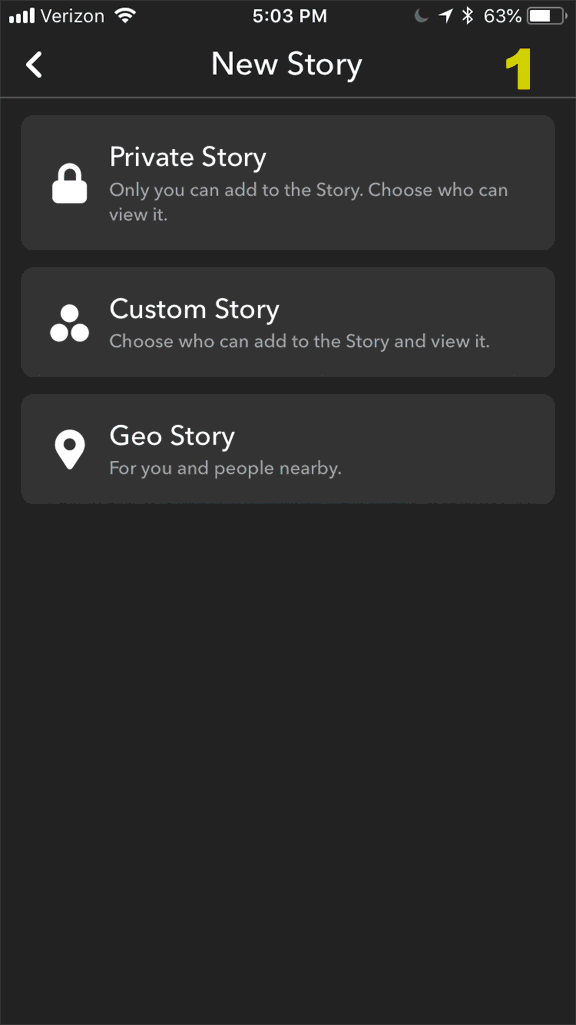No snap judgment: why invest in Snapchat?
 Some higher ed marketers are down on Snapchat.
Some higher ed marketers are down on Snapchat.
It’s inconvenient – you can’t schedule stories ahead of time or post from your desktop. You have to set 23-hour alarms to capture what little user-engagement data Snapchat makes available before your story vanishes. You never really know exactly how many friends you have.
Competing platforms such as Instagram Stories and What’sApp are growing faster than Snapchat in terms of the number of active users worldwide. But Snapchat is still the most popular social media channel for teens. And when it comes to recruitment, that’s the audience I care about.
According to the 2018 Ruffalo Noel Levitz E-Expectations report – hot off the press a few weeks ago – 67-70% of high school juniors and seniors are using Snapchat every day. And boy are they using it!
A new study conducted by the Pew Research Center reports that 9 out of 10 teens go online on their smartphones multiple times a day. And Snapchat is a frequent destination. Conducted in March and April 2018, the study found that the top three social media platforms used by U.S. teens ages 13-17 are You Tube, Instagram and Snapchat. Among teens who use more than one platform, Snapchat is the channel of choice.
Your prospective students are on Snapchat, so you need to have a presence there.
By and for Students
More than any of our other social channels, which have a broader audience and purpose, the SUNY Oneonta Snapchat is by, and for, current and prospective students.
Last year, nearly half of our Snapchat stories were created by students.
 Each summer, we find a few freshmen willing to document their move-in day and orientation experiences on our account. Throughout the year, we regularly host student takeovers highlighting popular campus and club activities, such as our Terpsichorean Dance Company show, our Halloween in the Halls trick-or-treating event, and OH-Fest, a free outdoor spring concert that has featured headliners ranging from Blues Traveler to Pitbull.
Each summer, we find a few freshmen willing to document their move-in day and orientation experiences on our account. Throughout the year, we regularly host student takeovers highlighting popular campus and club activities, such as our Terpsichorean Dance Company show, our Halloween in the Halls trick-or-treating event, and OH-Fest, a free outdoor spring concert that has featured headliners ranging from Blues Traveler to Pitbull.
Whenever we hear of a club or class doing something fun, visual or interesting off campus, we try to recruit one of the participants to take over our account. For example, our Hooked on Tonics club snapped from a regional a cappella competition, our Model United Nations team snapped from New York City, and our Habitat for Humanity club members shared their experience building houses in Florida over spring break.
We also love user-generated content, and we’ve featured everything from cute dog photos to selfies of students at their summer internship sites.
To increase our student presence on Snapchat even more, we recruited a core group of student social media ambassadors for our OSnap! team last fall. We use these students as a “cool or not cool?” sounding board and brainstorming group for ideas; assign them events to cover; and feature them as talent in stories such as our “Seven Days of Finals” giveaway.
Handing over the reins to students is valuable for a couple of reasons:
- It makes your Snapchat stories more authentic.
- It keeps the focus on your audience. Social media content should almost never be about you. Prospective students get enough “look-at-me!” marketing in college viewbooks, postcards, websites and emails. And they are savvy enough to see through poorly disguised sales pitches. Snapchat gives prospective students a real glimpse of what it’s like to be a student at your institution.
- Getting students involved also helps build your audience and extend your reach. When students are selected to take over the SUNY Oneonta account, they often promote it on their own Snapchat. This is one more chance for free advertising –“Hey, friends, I go to SUNY Oneonta!” –and usually also results in new followers for us.
Custom Story to the Rescue
Including Snapchat student takeovers in your content strategy poses challenges. Some schools have a dedicated device that they log in and give to students. We didn’t want to do that. It’s expensive, inconvenient and doesn’t allow for takeovers by students who are doing cool things off campus.
Sharing your account password with students and having them log in and out of your account is also not ideal because:
- It’s inconvenient. If you have two-factor authentication enabled, you will have to receive and share an access code sent by phone or email with your student before they can log into the account.
- It’s not secure. Even if you trust your student Snapchatters 100%, you are exposing yourself to risk by handing over the keys to an official school account, particularly when it’s a business account with a credit card on file for purchasing geofilters and ads.
- It’s a potential Terms of Service violation. Snapchat’s TOS is unclear in terms of whether sharing credentials to log in and out of the same account is allowed: “You will not share your password” seems to prohibit co-managing an account, but “You will not use or attempt to use another user’s account, username, or password without their permission” implies that sharing an account could be OK.
Snapchat’s Custom Story feature solves all these problems and more!
How to Use Snapchat Custom Story
To use Custom Story, your school first has to become mutual friends with your student Snapchatters. Then, follow these steps.
Step 1: Create a new story and choose Custom Story. Give it a name. Select the friends you want to be able to add to and view the story.
Step 2: Take a starting snap and send it to your new custom story. You’ll have to click on the small “Show More” type to reveal your custom story as an option.
Step 3: Now your student Snapchatter(s) can take and edit photos and videos while logged into their own Snapchat account, but send the snaps to your custom story. Only you and they will be able to see the custom story as it develops.
Step 4: Save the individual snaps from the custom story (or the whole story) to Memories. Tip: Turn on “Auto-Save to Memories.”
Step 5: When you are ready to share the story with all your Snapchat friends, go to Memories, select individual snaps (one at a time) or the whole story, and send them to “My Story.” Voila! You have just reposted the custom story on your school’s account.

From Creation to Curation
Besides the convenience of getting authentic student-produced content on your story – without ever having to share your password – Custom Story lets you be a curator. If your student Snapchatter makes a bad typo, forgets to set the snap duration to 10 seconds for a photo with a long caption, or doesn’t speak clearly in a video – you have veto power. No snap will be posted on your account until you say so.
So far, we’ve only used Custom Story for individual takeovers. The real fun will be using it to curate content from multiple students all posting at once! We’re excited to try this out on move-in day and orientation. Because, at least for me, the only thing more fun than seeing one student’s story is hearing from MANY different students!
Just another reason why, imho, Snapchat is still > Instagram Stories.
How about you? Have you used Custom Story? Share your experiences in the comments!
Meet the Author: Lisa Miller
Lisa Miller is the director of marketing at SUNY Oneonta, and a graduate of the Higher Ed Experts’ professional certificate program in Social Media Marketing for Higher Ed.
Tags: Higher Ed Marketing Memos, Higher Ed News


Hi Lisa! Great tips! We do still use Snapchat but primarily only for takeovers by students so custom stories will be a big help.
I do caution schools from misinterpreting the use of students for connecting with or researching colleges. Per the same E-Expectations study, only 7% of seniors and 12% of juniors use Snapchat for obtaining information about a college, down 12% for seniors from last year. Instagram, YouTube and Facebook still are the most used platforms (36%, 39% and 32% respectively for seniors).
Best,
Lori
Good point, Lori. Snapchat is not seen as a best channel for college info by prospective students. However, when you look at the Encoura Eduventures Research, you can see that about as many prospective students have used (or plan to use) Snapchat at least once a month for their college research as those who did or plan to use Facebook or Twitter (between 17 and 19% – nothing huge). Instagram is 10-percentage point ahead of this pack.
This is definitely a complex picture, which is probably why the integrated multichannel approach is still the way to go. 🙂